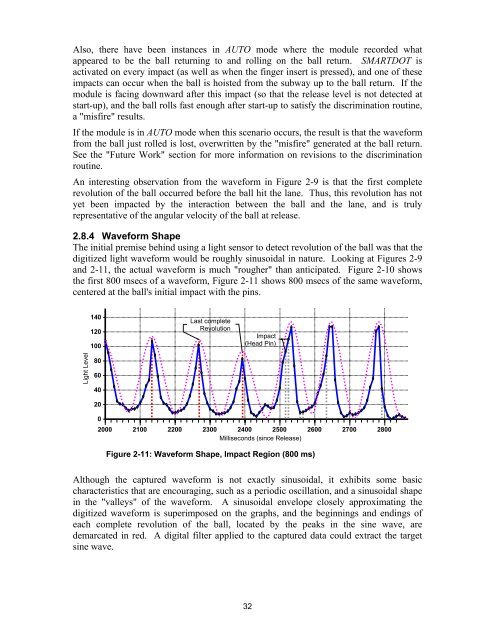A Performance Analysis System for the Sport of Bowling
A Performance Analysis System for the Sport of Bowling
A Performance Analysis System for the Sport of Bowling
Create successful ePaper yourself
Turn your PDF publications into a flip-book with our unique Google optimized e-Paper software.
Also, <strong>the</strong>re have been instances in AUTO mode where <strong>the</strong> module recorded what<br />
appeared to be <strong>the</strong> ball returning to and rolling on <strong>the</strong> ball return. SMARTDOT is<br />
activated on every impact (as well as when <strong>the</strong> finger insert is pressed), and one <strong>of</strong> <strong>the</strong>se<br />
impacts can occur when <strong>the</strong> ball is hoisted from <strong>the</strong> subway up to <strong>the</strong> ball return. If <strong>the</strong><br />
module is facing downward after this impact (so that <strong>the</strong> release level is not detected at<br />
start-up), and <strong>the</strong> ball rolls fast enough after start-up to satisfy <strong>the</strong> discrimination routine,<br />
a "misfire" results.<br />
If <strong>the</strong> module is in AUTO mode when this scenario occurs, <strong>the</strong> result is that <strong>the</strong> wave<strong>for</strong>m<br />
from <strong>the</strong> ball just rolled is lost, overwritten by <strong>the</strong> "misfire" generated at <strong>the</strong> ball return.<br />
See <strong>the</strong> "Future Work" section <strong>for</strong> more in<strong>for</strong>mation on revisions to <strong>the</strong> discrimination<br />
routine.<br />
An interesting observation from <strong>the</strong> wave<strong>for</strong>m in Figure 2-9 is that <strong>the</strong> first complete<br />
revolution <strong>of</strong> <strong>the</strong> ball occurred be<strong>for</strong>e <strong>the</strong> ball hit <strong>the</strong> lane. Thus, this revolution has not<br />
yet been impacted by <strong>the</strong> interaction between <strong>the</strong> ball and <strong>the</strong> lane, and is truly<br />
representative <strong>of</strong> <strong>the</strong> angular velocity <strong>of</strong> <strong>the</strong> ball at release.<br />
2.8.4 Wave<strong>for</strong>m Shape<br />
The initial premise behind using a light sensor to detect revolution <strong>of</strong> <strong>the</strong> ball was that <strong>the</strong><br />
digitized light wave<strong>for</strong>m would be roughly sinusoidal in nature. Looking at Figures 2-9<br />
and 2-11, <strong>the</strong> actual wave<strong>for</strong>m is much "rougher" than anticipated. Figure 2-10 shows<br />
<strong>the</strong> first 800 msecs <strong>of</strong> a wave<strong>for</strong>m, Figure 2-11 shows 800 msecs <strong>of</strong> <strong>the</strong> same wave<strong>for</strong>m,<br />
centered at <strong>the</strong> ball's initial impact with <strong>the</strong> pins.<br />
140<br />
120<br />
100<br />
Last complete<br />
Revolution<br />
Impact<br />
(Head Pin)<br />
Light Level<br />
80<br />
60<br />
40<br />
20<br />
0<br />
2000<br />
2100 2200 2300 2400 2500 2600 2700 2800<br />
Milliseconds (since Release)<br />
Figure 2-11: Wave<strong>for</strong>m Shape, Impact Region (800 ms)<br />
Although <strong>the</strong> captured wave<strong>for</strong>m is not exactly sinusoidal, it exhibits some basic<br />
characteristics that are encouraging, such as a periodic oscillation, and a sinusoidal shape<br />
in <strong>the</strong> "valleys" <strong>of</strong> <strong>the</strong> wave<strong>for</strong>m. A sinusoidal envelope closely approximating <strong>the</strong><br />
digitized wave<strong>for</strong>m is superimposed on <strong>the</strong> graphs, and <strong>the</strong> beginnings and endings <strong>of</strong><br />
each complete revolution <strong>of</strong> <strong>the</strong> ball, located by <strong>the</strong> peaks in <strong>the</strong> sine wave, are<br />
demarcated in red. A digital filter applied to <strong>the</strong> captured data could extract <strong>the</strong> target<br />
sine wave.<br />
32
















